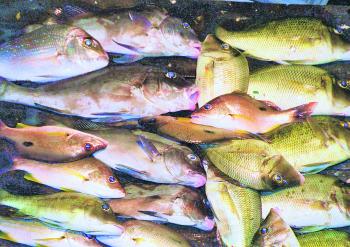It’s easy to remember when we might have comfortably planned our fishing trips by looking at the calendar and checking off the tidal and weather predictions. In Hervey Bay, you might’ve heard it said that you could expect a good catch of diver whiting any time after Anzac Day or expect the bream to be going crazy from the first spring tide in May.
Courtesy of climate change, water temperatures are on the rise along our coast. Things are changing so much that we may be well out in our predictions for this month, or any month for that matter.
Diver whiting have been a strong favourite for local and visiting anglers for generations. They have consistently shown up during the autumn and winter months over the sandy and sea grass shallows. They come here to feed prior to spawning. I am uncertain as to their whereabouts during the summer months and if they move in from deeper areas. Whatever the case, with inshore water temperatures rising, the spawning time may not be triggered until later in the year. Not only do we expect the season to make a later start (perhaps some time later in May), but we might expect it to be shorter. Not good news for the keen diver whiting specialist, and probably not good news for the sustainability of this whiting population. Something for the experts to ponder.
Much of what I have said here might apply to bream. Although common catches occur throughout the year, it is during the winter months that they congregate in their preferred feeding and spawning areas. From my own observations it appears that each year sees a slightly later start to the season, at least in Hervey Bay. Hopefully early June should see plenty of action in the Mary estuary and around the rock ledges of bay islands.
With inshore water temperatures remaining high, the shallow reefs are expected to perform well until the end of this month. As the cooling progresses, the first species to leave should be the grass sweetlip (coral bream), particularly the better quality fish. Blackall will continue to be plentiful and are likely catches right through winter. Slightly cooler waters will see plenty of small, but legal, snapper move in over the shallows.
Javelin (locally known as grunter or trumpeter) have been reasonably plentiful throughout the Fraser Coast for as long as I can remember. The Mary and Susan Rivers, Ungowa and German Creek are just a few areas that have often fished well. They have also been plentiful on many of the wide grounds in northern parts of the bay. Catches of javelin have improved generally over the last years but most recently they have also been turning up in numbers on the shallow reefs, particular those fringing Point Vernon.
We are now seeing fish that are more associated with more northern waters, becoming more plentiful in Hervey Bay, and further south. Apart from javelin, threadfin salmon and golden snapper are now starting to show up in Hervey Bay catches.
We can expect that as water temperatures rise we might see more appearances of tropical species but we can rightly wonder about the cool water species that are important to us in the bay and around Fraser Island. Is there a chance that, although they might still be plentiful, a shift in their range towards the south could be coming about? The last couple of diver whiting seasons have been dismal but I believe, on good authority, that areas like the Blue Hole in Moreton Bay have been fishing well. There may still be the very odd luderick browsing around the snags of Hervey Bay’s creeks, but the fact is that they have almost completely disappeared.
Over on Fraser Island it has been a bit of a mixed bag as far as driving conditions are concerned. The southern beach south of Dilli Village has not been easy with eroding gutters and creek washouts. Further north the beach is much more settled but by the time this report reaches you the situation could be vastly different. Some of the coffee rock outcrops like those at Poyungan Rocks and Yidney have lost much of their sand with vehicles needing to use bypass tracks. Further north, those travelling to Sandy Cape have found the Ngkala Rocks bypass being difficult but negotiable by experienced drivers.
The usual beach species including whiting, dart, bream and tarwhine have been keeping anglers busy. Snub nose dart have attracted some interest lately with fish up to 6kg being taken north of Eli Creek and near Cathedral Beach resort. This month is still much too early for the famous spawning tailor season. The earliest that I have seen it start is mid June but realistically late July should see the action start. The odd good tailor can be caught this month but these wouldn’t be expected to be anywhere near spawning condition.
Sand whiting, flathead and bream have been located around the creek mouths and coffee rocks off the western beach. With the Moon Point road now closed, the beach north of Coongul Creek is accessed via the Woralie Track. Fraser’s western beach is a great alternative when strong south easterlies make fishing too difficult on the ocean beach.
| Beaches south of Coongul Creek are becoming more difficult to reach from the island’s eastern coast but for Hervey Bay based anglers it is a short 10km run across the bay from the Urangan boat harbour. | Of course conditions may not always be favourable but sea permitting, these beaches cannot be beaten for excellent whiting, bream and flathead fishing along with great family outings. |
|---|

There are still plenty of opportunities to score a mixed bag or reef fish across the bay.




